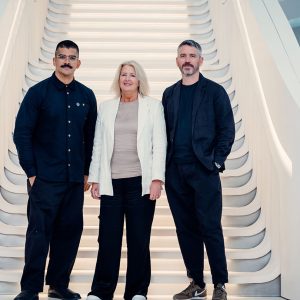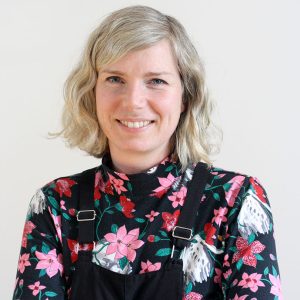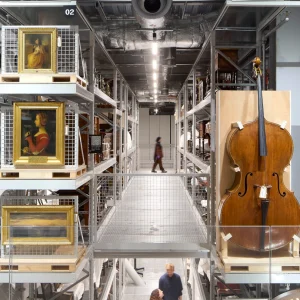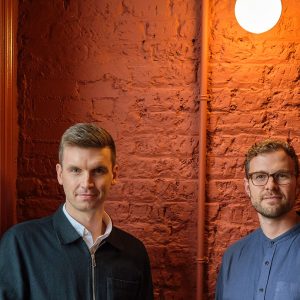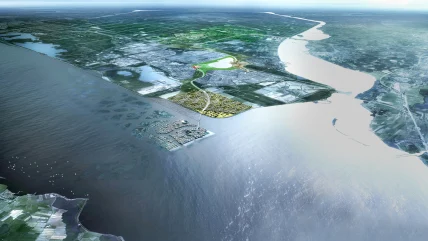
THE FIGURES are now in: 2024 was officially the hottest on record, according to a January 2025 report by the World Meteorological Organization (WMO). But while some parts of the world suffered extreme drought and catastrophic wildfires, for most in northern Europe and the US, it was rain that caused the greatest disturbance. ‘This year we saw record-breaking rainfall and flooding events and terrible loss of life in so many countries, causing heartbreak to communities on every continent,’ says WMO secretary general Celeste Saulo.
Why would a warmer world mean a wetter world? That question was answered succinctly in a 22 November 2024 episode of The Climate Question on BBC World Service radio, by BBC weather forecaster Louise Lear: ‘A warmer atmosphere has the ability to hold more moisture, and therefore when it rains we are tending to see more significant rain events. You will have wetter seasons across the globe that now (bring) phenomenal amounts of rainfall.’ The horrendous flash floods in Valencia in November drove that point home vividly – with a year’s worth of rain falling in eight hours.
What does this mean for our homes and cities? Before we head for the highlands should we take encouragement from the way the world’s most progressive coastal country is responding? The Netherlands has well over a third of its land mass below sea level at any one time, having reclaimed as much as 50% of it (18,000km2) from the sea over the last centuries. But thanks to a sophisticated system of dikes, pumps and sand dunes, you almost never hear its name in the litany of countries suffering flooding.
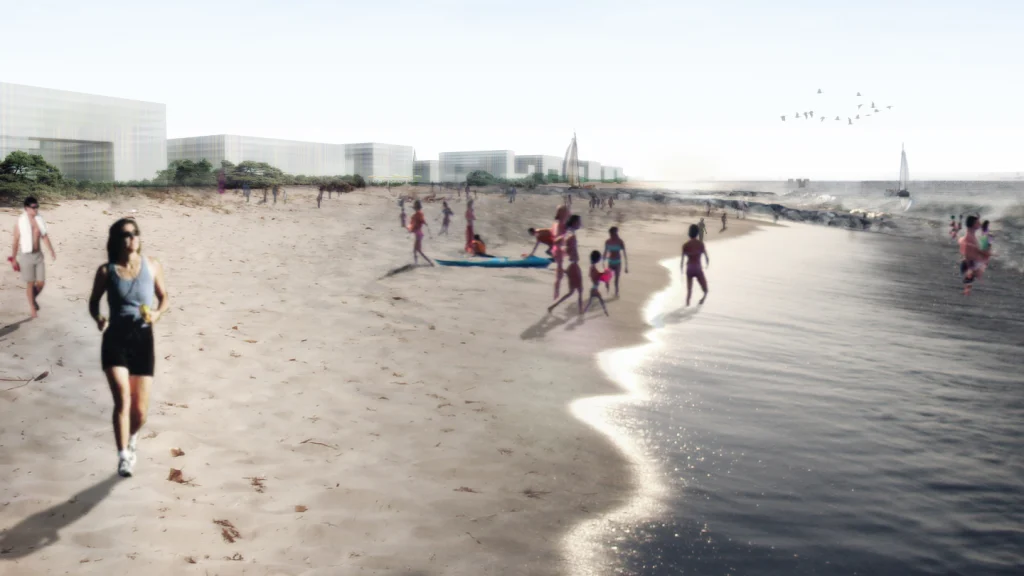
Instead, it has turned its main geographic vulnerability into one of its biggest assets, with Dutch architects, landscape designers and engineers in demand all around the world for their expertise in flood resilience. The Netherlands, it seems, has a national strategy that is anything but fearful of water; instead, the philosophy seems to be to work with and around the elements, enjoying the positive aspects of co-location while mitigating against the worst. And one of its most effective moves – turning the majority of its 100km-plus coastline over to extensive dunes and beaches, rather than hard infrastructure – has been so effective in demonstrating the benefits of a more ‘porous’ approach to the public realm, it is now being copied in cities around the world.
And now these engineers, having demonstrated how good they are at reverse engineering coastlines for human benefit, are seeing if they can retro-engineer in order to bring greater benefit nature, in one of the biggest nature restoration projects in the whole of Western Europe. The vast Markermeer lake was created in 1976 when a dam was built between Enkhuizen and Lelystad, reclaiming land from the sea but also disconnecting this 700km2 body of water from the sea and surrounding rivers. Over time, the lake stagnated: with barely any shores, and wind and waves regularly churning up the sediment from the shallow (2-4m deep) lake floor, sunlight was unable to percolate through to nourish the plants on which fish and birds depend. This led to a steep decline in their populations. An innovative solution proposed using the very silt and clay that is clogging up the water to construct new islands that prioritise bird and plant life, while contouring the lake bed to improve the flow and filtration of the water, and rebalance the delicate aquatic ecosystem (see Marker Wadden case study). Luckily, they had just the local expertise they needed for the job, courtesy of Boskalis, a Dutch company that has built a global legacy of massive land and water projects, not least Palm Island in Dubai and, more recently, widening the Suez Canal.
Commissioned by Natuurmonumenten, the Netherlands’ largest private organisation for nature conservation, with over 100,000 hectares of land and water under its jurisdiction, the resulting complex of islands prioritises biodiversity, with just a few, lightweight timber structures offered for visitors and researchers. It’s the kind of ambitious, mind-boggling project that seems second nature to the Dutch: over 30 million litres of sand and sediment was cleared and relocated around the lake in this initiative. Since completion in 2021, the water quality and wildlife is improving, with rare species of plants, insects, fish and birds now returning to the marshes, mudflats, shallow pools, creeks and channels.
I had the privilege of visiting this biodiverse haven in October 2024, and the experience of being on this little archipelago in the middle of a vast body of water is exhilarating.
Flevoland, the region where the Marker Wadden sits, is itself an extraordinary reclamation project, only a little more than 60 years old. Protected by the aforementioned dikes and dunes, most of Flevoland sits 6m below sea level. It is now the fastest-growing region in the Netherlands. Only a 20-minute train ride from Amsterdam, new towns such as Almere are booming. But residents are not just commuters to Amsterdam or Rotterdam; there are high-tech manufacturing and logistics businesses taking advantage of its location in the centre of the country, with two thriving ports nearby, plus an airport and fast roads. Furthermore, the good thing about new (or newly reclaimed land) is that nobody complains when you stick wind farms there – Flevoland produces 25% of all renewable wind energy for the country.
The housing that has arrived in this new region has been a mix of experimental and expedient. When the first houses emerged, around 1976, they were low-rise and cheaply constructed, providing homes for the first 150,000 settlers, but they are regarded as bland at best, and were clearly not sufficiently appealing to draw more aspirational, professional residents. Since then, leading Rotterdam-based practice MVRDV – creators of Rotterdam’s iconic Rooftop walkway (infusing the upper storeys of key Rotterdam buildings with plants and walkways to create a greener ecosystem above this dense, urban city) has come up with more enticing and libertarian alternatives. MVRDV’s 2008 masterplan for Almere divided it into four regions, with a huge amount of individual choice as to what is built, how and where (see Almere Masterplan case study).
Continuing in this spirit of self determination, and living in balance with nature, I toured the inspiring Utopia Island project – an area of reclaimed land on the edge of Almere, which was left untouched for over 30 years, and thus was able to establish its own plant and wildlife ecology (see Utopia Island and Floriade Expo case study). The plot is part of the local economic ecosystem too – inviting partnerships with local businesses to grow the materials to support brewing and herbal entrepreneurs. Furthermore, it offered an authentic test bed for a whole new kind of horticultural expo, Floriade, in 2022.
Tidal Park Keilehaven by De Urbanisten is another fine example of waterside ecosystem restoration with the reclamation of some of Rotterdam’s hard, harbour landscaping to create a water-fringed park (see Tidal Park Keilehaven case study).
Sadly, I didn’t get to visit Utrecht where, in 2020, and at the cost of £860m, the city returned a six-lane vehicle highway into a canal, the Catharijnesingel, connecting it to an existing canal network and restoring this tranquil waterway to the condition it had enjoyed from 1122 until the 1960s when it was filled in for car use. And it was all thanks to public support from a referendum in 2002. If Dutch architects, planners and engineers are so proactive in their strategies for climate resilience and regreening, maybe it’s because they feel supported by an engaged public?
Either way, there is much to be learned from the new Dutch architecture, to find ways, as the Dutch Design Awards judges said about Marker Wadden, ‘Not to fight against water, but rather to live in harmony with it’.
CASE STUDY
ALMERE MASTERPLAN
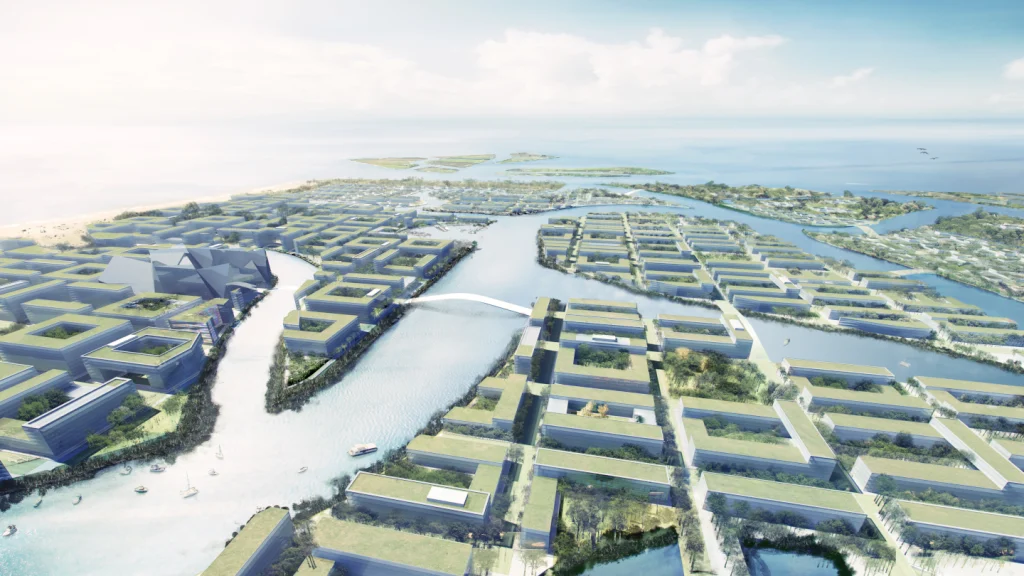
In 2008, Rotterdam-based architects MVRDV was tasked with coming up with a vision for Almere, the Netherlands’ newest city, only reclaimed from the Ijselmeer sea between 1959-1968. The brief was to grow the current population of just over 200,000 by at least another 60,000 by 2030, and do so in a way that would boost not just housing and economic opportunity but also infuse each new neighbourhood with a distinctive social and ecological culture, to offer new qualities of life. All being well, by 2030, it will be the fifth-largest city in the Netherlands.
Working closely with the municipality, MVRDV proposed four distinct areas: Almere IJ-land, a new island off the coast in the IJ-lake; Almere Pampus, focused on the lake and open to experimental housing; Almere Centre, an extended city centre developed along the existing lake; and Almere Oosterworld, devoted to a new kind of rural and organic urbanism.
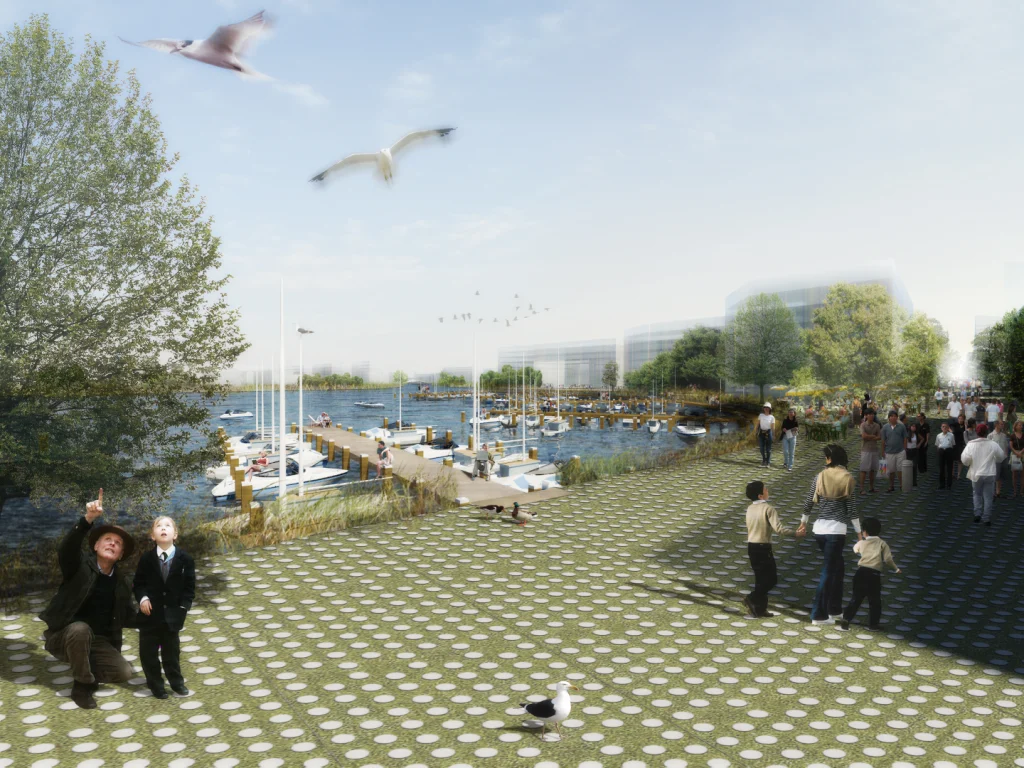
The new neighbourhoods are on an infrastructural axis, which also connects to Amsterdam – the nearest major city, and one to which many Almere residents already commute, a mere 20-minute train ride away – while Almere Oosterworld in the east will also enjoy enhanced connections to Utrecht. The projects are all underway currently, with construction having started in 2011.
Almere Oosterworld is one of the most fascinating from the perspective of designing with nature to the fore. Residents have great freedom of individual choice in construction but have to follow MVRDV’s rule that in each neighbourhood plot, only 18% can be built on, 8% should be roads, 13% public greenery, 2% water and 59% urban agriculture. Residents have to work closely within their immediate communities to organise layout and infrastructure – as a reporter, who visited the project for the African Journal of Landscape Architecture, concluded: ‘You can build your fantastic dream (home) in Almere, but you have to build the road leading to it as well.’
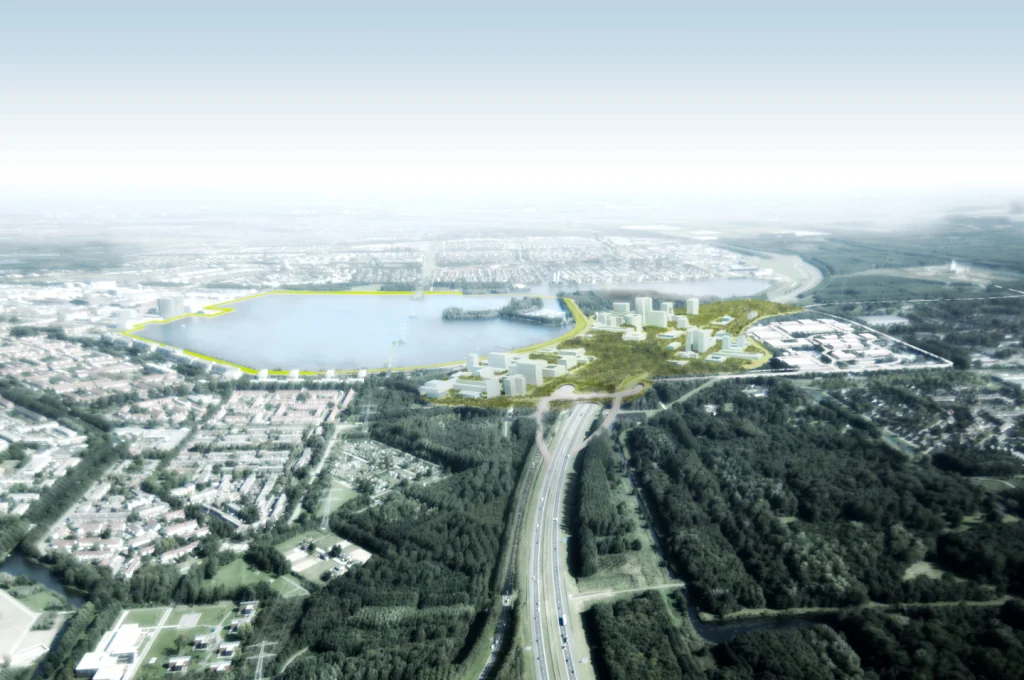
The project is still being closely monitored to see what lessons can be learned, but MVRDV director Winy Maas affirms that what they have created is not so much an experimental city, but ‘a city where experiments can happen’.
Client Municipality of Almere
Masterplan MVRDV
Start date 2011
Completion 2030
CASE STUDY
MARKER WADDEN
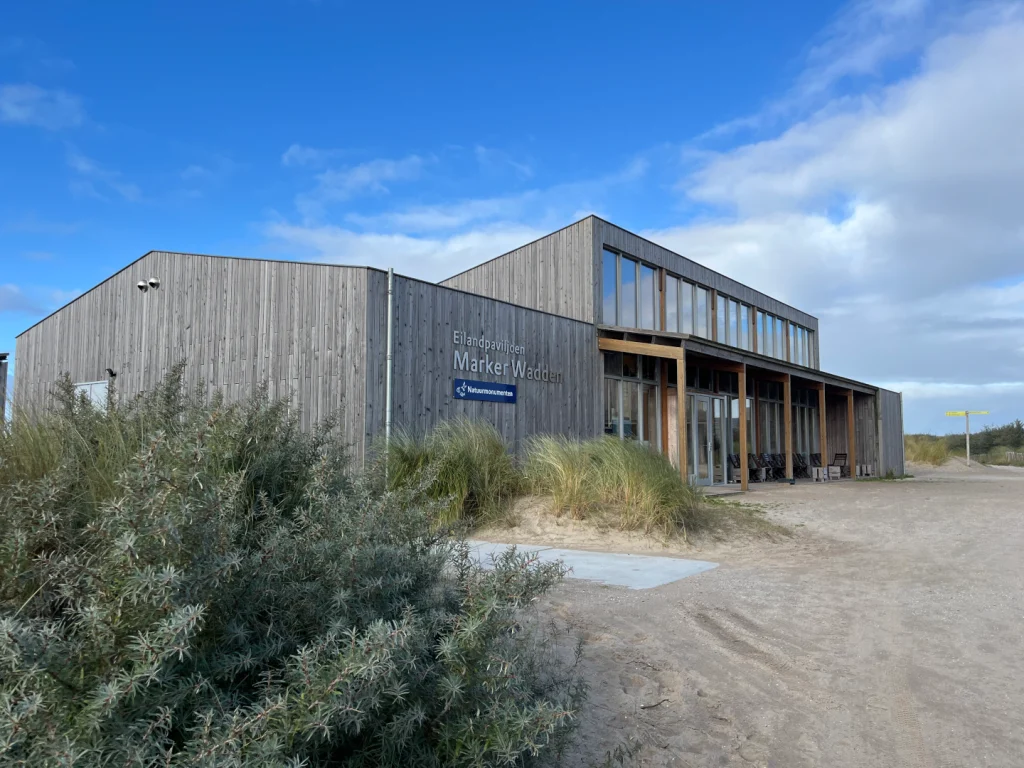
Winner of a 2021 Dutch Design Award, the Marker Wadden is a new nature reserve reclaimed from a freshwater lake and designed to prioritise plant and bird well-being rather than that of humans. This innovative project showcases Dutch ingenuity and the New Dutch values, with an archipelago constructed from clay and silt dredged out of the Markermeer lake. Five connected islands consist primarily of marshlands and shallow waters, in which rare and endangered species of plants and birds are now thriving. There is minimal accommodation for humans, and only on the largest island, in the form of 15 lightweight timber-clad structures, designed by Palmbout Urban Landscapes and Ziegler|Branderhorst. Comprising a welcome pavilion and visitor café, cabins for visitors, researchers and volunteers, a research station and a bird hide, they are made from prefabricated wooden blocks that can easily be transported over land or water. Self-contained bathrooms, toilets and kitchen units are shipped intact and positioned on a large wooden frame supported by a spiral pile foundation. The prefabricated blocks support the roof structure.
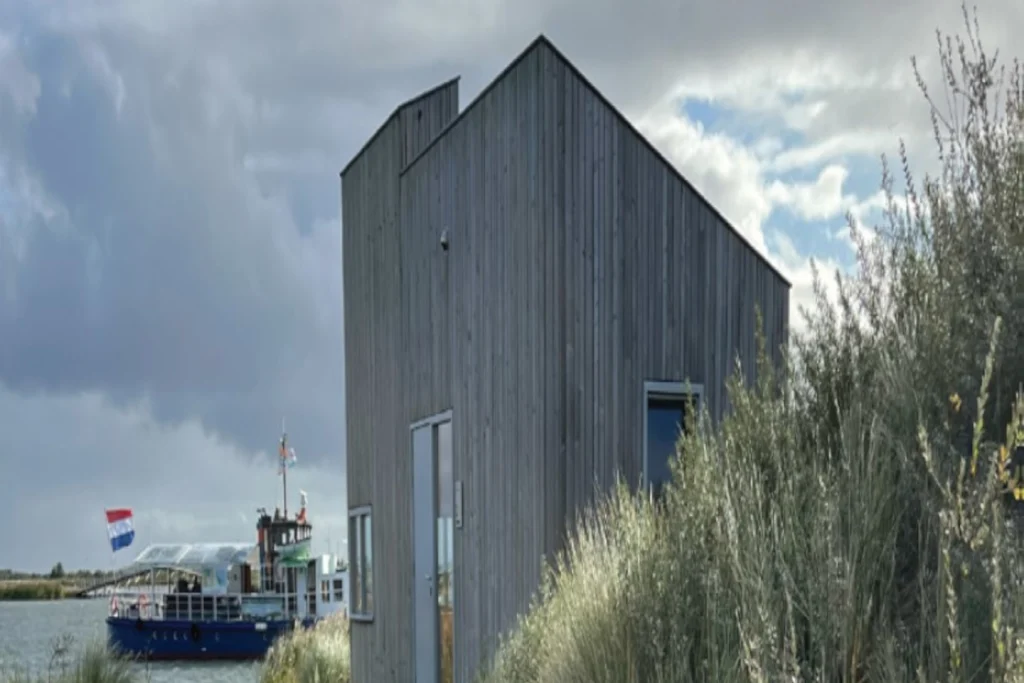
Their shape, situation and materials are completely complementary to the wild, watery setting, with roofs pitched in the direction of the sun to capture maximum solar power (providing 80% of all energy requirements. A ground-coupled heat exchanger provides the rest). All are single storey and clad with now nicely weathered timber. Only the quirkily shaped lookout rises noticeably above the dunes. A small number of visitors are allowed on the island at any time. And, whether staying in the simple, cabin accommodation or daytrippers, all have to travel there in an hour’s journey by passenger boat from the nearby Lelystad jetty. For those staying in this peaceful haven, there are windswept beaches aplenty, and 18km of walking paths.
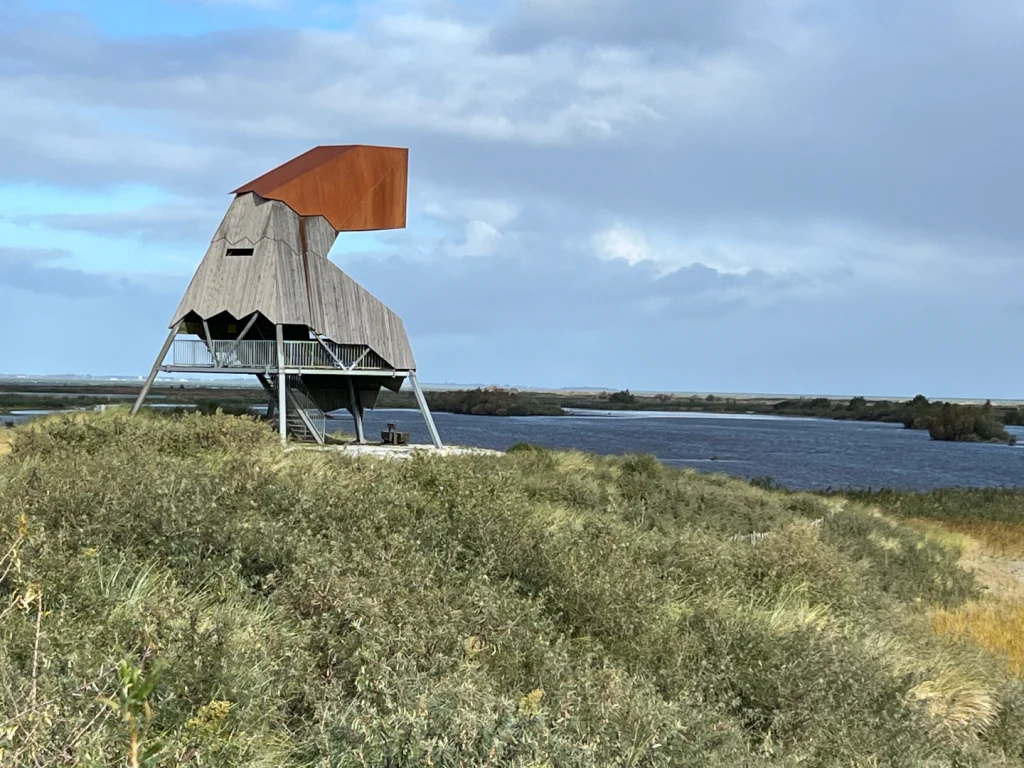
Client Natuurmonumenten (Dutch Society for Nature Conservation) and Rijkswaterstaat (the Executive agency of the Ministry of Infrastructure and Water Management)
Dredging and island engineering Boskalis
Architecture Palmbout Urban Landscapes with Ziegler|Branderhorst
Landscape design Vista Landscape Architecture and Urban Planning
Area 1,300 hectares
Budget €90m
Completed 2021
Landscaping consultants Arturo Flores
Awards Habitat winner, Dutch Design Awards 2021
CASE STUDY
UTOPIA ISLAND AND FLORIADE EXPO
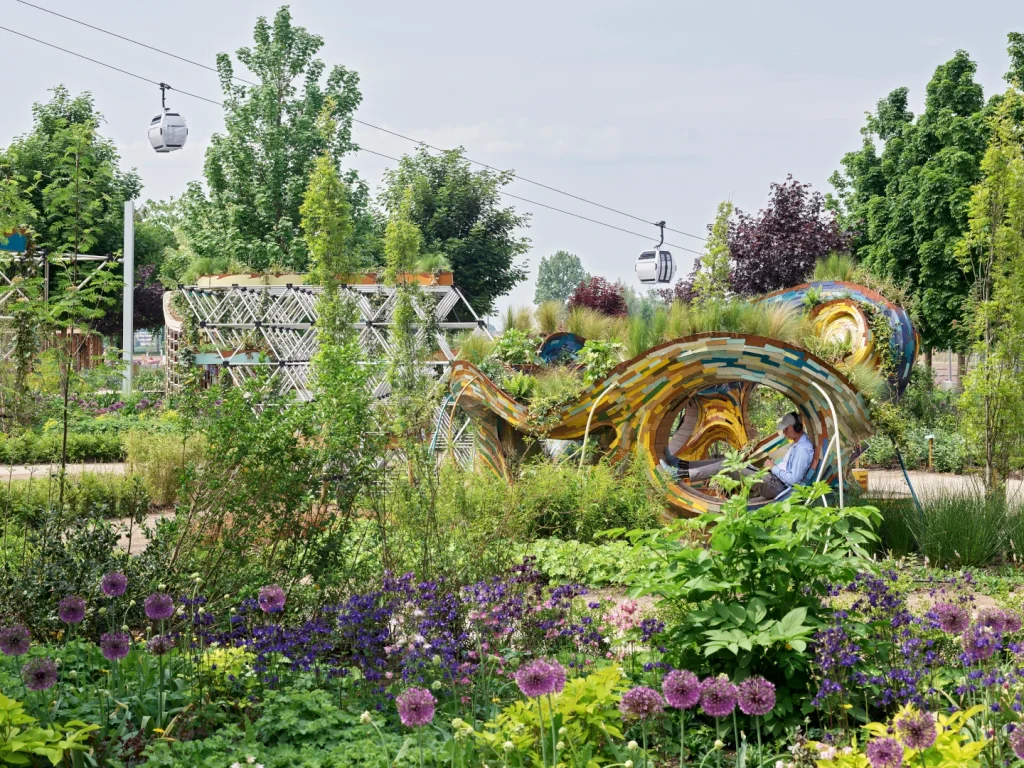
Utopia Island was stablished by architect Xavier San Giorgi, on a plot reclaimed from the sea, and then neglected for 30 years. It is now a thriving hub of biodiversity, with San Giorgi and his largely volunteer team running it as a foundation to encourage people to support and engage in perennial farming and ecosystem restoration. The programme includes food growing, education (through regular engagement with local schools as well as further education institutions), collaboration with local businesses and also space for contemplation, surrounded by specially commissioned eco art.
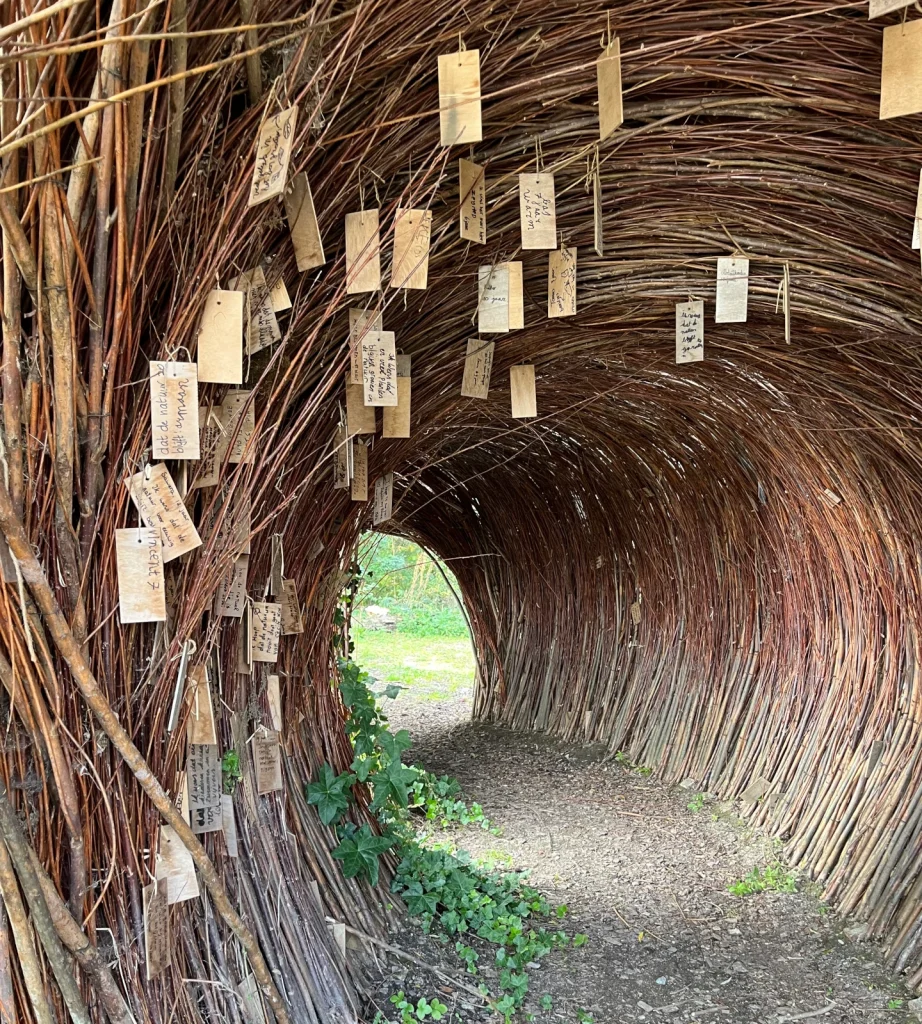
Says San Giorgi: ‘I wanted to see if we could create a landscape in our cities that restores nature but at the same time directs us to behave and live in balance with it.’ Divided into three discrete zones, the first is to do with education and food growing, the second is a natural forest along the lake shore, with both naturally arising and sown indigenous species of plants. The third area is more specifically landscaped for education and relaxation, liberally sprinkled with eco art works such as the willow sculptures by Will Beckers, part of his Willowman initiative, including a tunnel bearing little parcel tags of wishes, written on by local schoolkids who often use the area for after-school education and recreation.
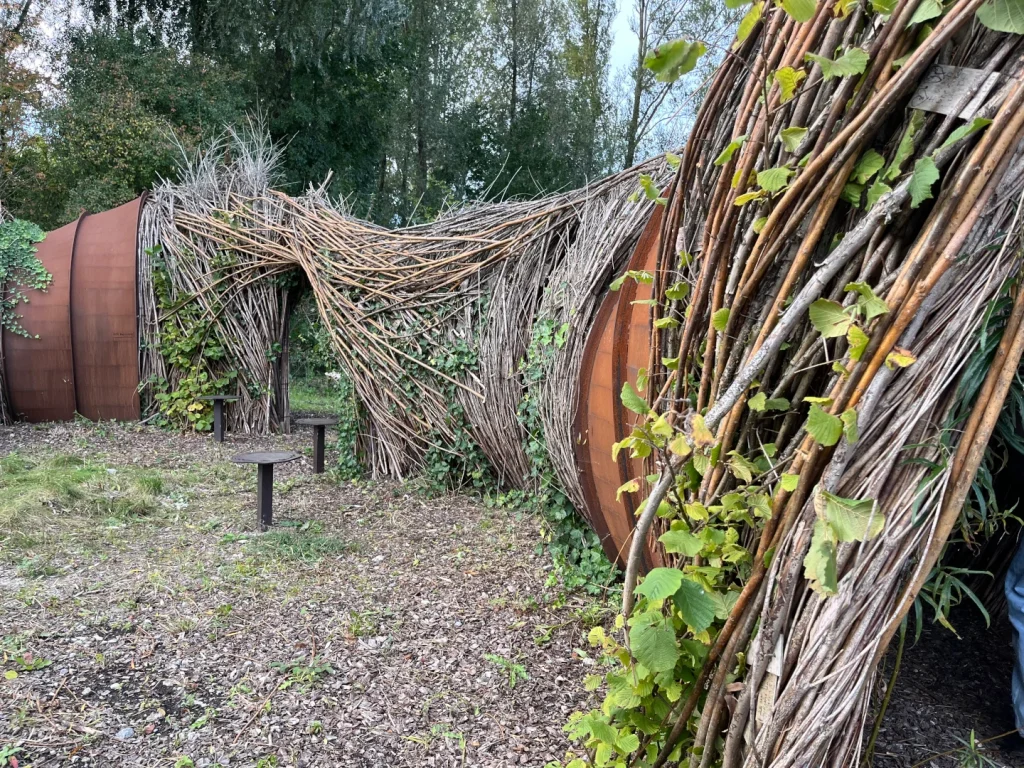
But more than a mere community garden or local allotment, Utopia Island is open to business opportunities that support their plant-centric agenda, growing tea for a local tea company, walnuts for a walnut liqueur company and hops for a local brewery. San Giorgi concludes: ‘We have weasels and beavers, an amazing array of insects. We know our presence grows insect and animal diversity. We hope this garden provides a model for the world.’
In 2022, Utopia Island and the surrounding semi-wild urban realm hosted a radical version of the Netherlands’ Floriade Horticultural Exhibition, a once-in-a-decade event. The event brought 400 of the most cutting-edge ideas and inspirations that were then emerging from the nation’s architects, designers and bio-engineers as well as horticulturalists. This included a sustainable pilot home made from 93% recycled plastic. Masterplanned by MVRDV, the theme Growing Green Cities foregrounded projects that prioritised plant diversity, health and the simple pleasure of being in nature. The 60-hectare site became an arboretum, with a library of trees and plants arranged in alphabetical order across the grid-style layout. Working with landscape architect Niek Roozen, the plants totalled 40,000 shrubs, 200,000 perennials and one million bulbs. Dutch growers donated 2,800 trees for this edition. All species selected were either indigenous or climate appropriate. At the time, MVRDV founding partner Winy Maas said: ‘This arboretum gives an opportunity to see all the plants of the Dutch climate zone, at the same time showing what they contribute to the green city.’
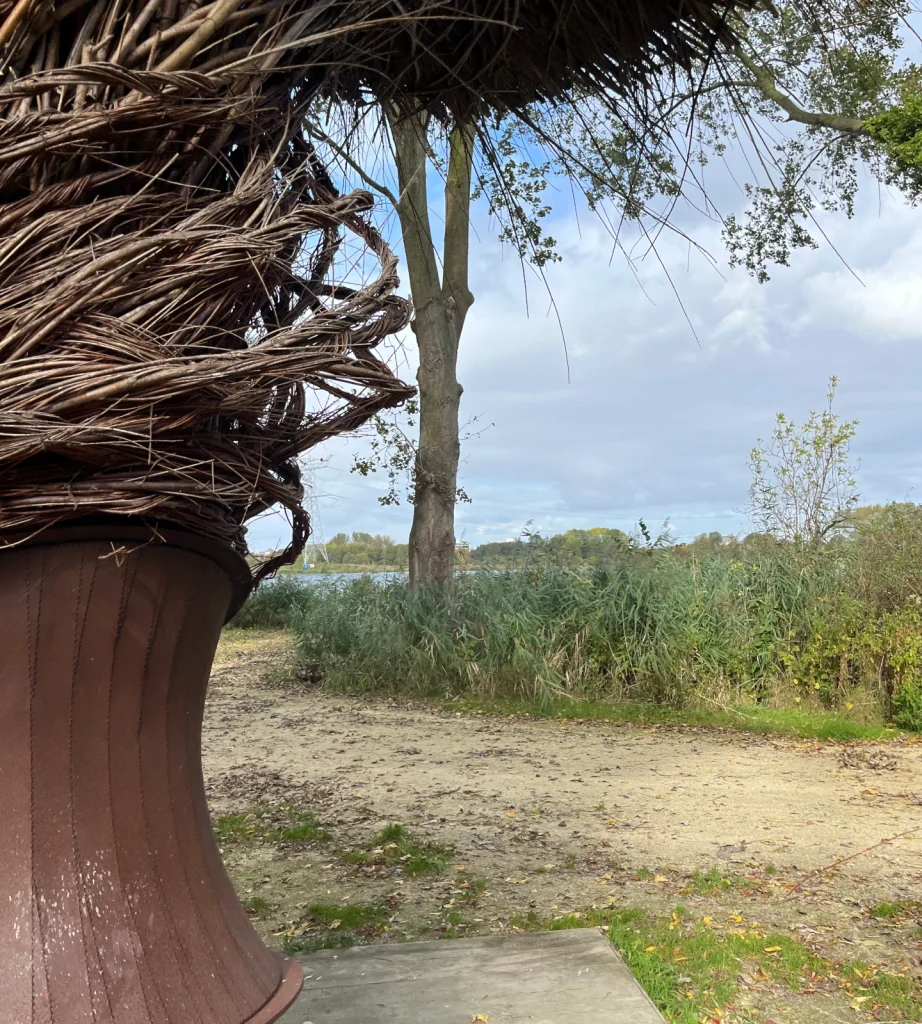
Two new bridges were constructed connecting Utopia Island to its surrounding landmass, both made from cement-free concrete, which integrated waste products gathered in the locality. Various architects were encouraged to respond to the ethos, providing buildings that celebrated or incorporated as much greenery as possible. Resulting pavilions included those by Erik van Egeraat, Paul de Reiter Architects, René van Zuuk, SeARCH and Studio RAP. The finishing flourish was the incorporation of a permanent landmark, the 43.5m Flores Tower at the centre of Floriade park, which was covered in a colourful façade designed by MVRDV, in collaboration with Arttenders and the Flemish artist Axel Verhaest.
Client Dutch Horticultural Council (NTR)
Masterplan architects MVRDV
Landscape architects Niek Roozen with Christiaan Pfeiffer from Almere Municipality
Public space architects ZUS Architects
Area 60 hectares
Construction Amvest and Dura Vermeer
CASE STUDY
TIDAL PARK KEILEHAVEN
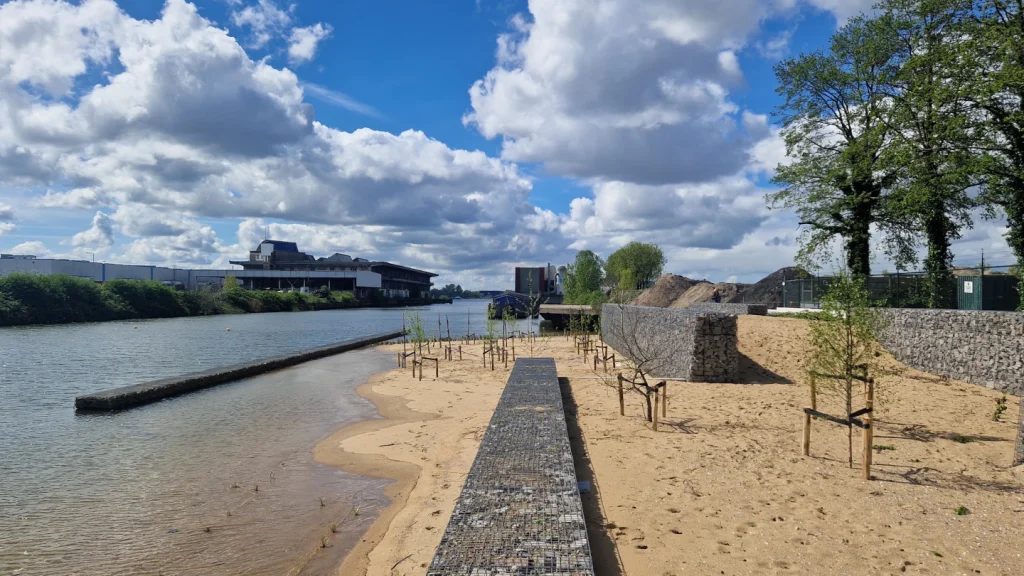
Rotterdam has more than 70km of stony quays along its huge network of docks and waterways, many of which are being absorbed into new neighbourhoods. But one of the things missing in these neighbourhoods is park and leisure space. De Urbanisten has a new vision for how these former industrial areas can be retrofitted for nature and well-being, with the Keilehaven Tidal Park the first of its kind. Instead of elevating visitors above the tide, this park celebrates the rise and fall of the tide (between 1.2m to 1.5m difference from low to high) to create a kind of beach garden filled with appropriate materials and aquatic greenery. All of it will be accessible at low tide, but only part of it at high tide. In this way, the practice hopes to: ‘Create a dynamic public space with a chance of an exceptional experience of nature, an encounter with a kingfisher, a dragonfly or cormorant that are drawn to the rich underwater life.’ The first tidal park is set within the former industrial zone of Keilehaven. But further tidal parks are planned. Ultimately, it is hoped these will help residents to reimagine the riverside as ‘a migration route for fish and other animal species in search of rich nutrients and resting places.’
Where construction materials are required, for this first iteration, De Urbanisten has used recycled materials released from other city projects, such as rubble, quay cobblestones or gabions.
Client The City of Rotterdam
Architecture/landscaping De Urbanisten and ARK Nature Development
Started: 2018
Completed 2024
Frequently asked questions
-
What innovative strategies has the Netherlands implemented to manage flooding?
The World Meteorological Organization reported that 2024 was officially the hottest year on record, highlighting extreme weather events such as severe droughts, wildfires, and unprecedented rainfall and flooding in various regions, particularly in northern Europe and the US.
-
What is the Marker Wadden project, and what are its goals?
The Marker Wadden project is a nature restoration initiative in the Markermeer lake, aiming to improve biodiversity by creating new islands using sediment from the lake. This project enhances water quality and supports the return of rare plant and animal species, demonstrating a commitment to ecological balance.
-
How is the region of Flevoland contributing to renewable energy in the Netherlands?
Flevoland, a reclaimed land area, produces 25% of the Netherlands' renewable wind energy. Its strategic location and innovative housing developments, alongside a focus on sustainability, make it a rapidly growing region that supports both residential and industrial growth.
-
How does a warmer atmosphere affect rainfall patterns?
A warmer atmosphere can hold more moisture, leading to more significant rain events. This results in wetter seasons globally, as evidenced by extreme rainfall incidents like the flash floods in Valencia, where a year's worth of rain fell in just eight hours.
-
What record did the World Meteorological Organization report for 2024?
The World Meteorological Organization reported that 2024 was officially the hottest year on record, highlighting extreme weather events such as severe droughts, wildfires, and unprecedented rainfall and flooding in various regions, particularly in northern Europe and the US.

